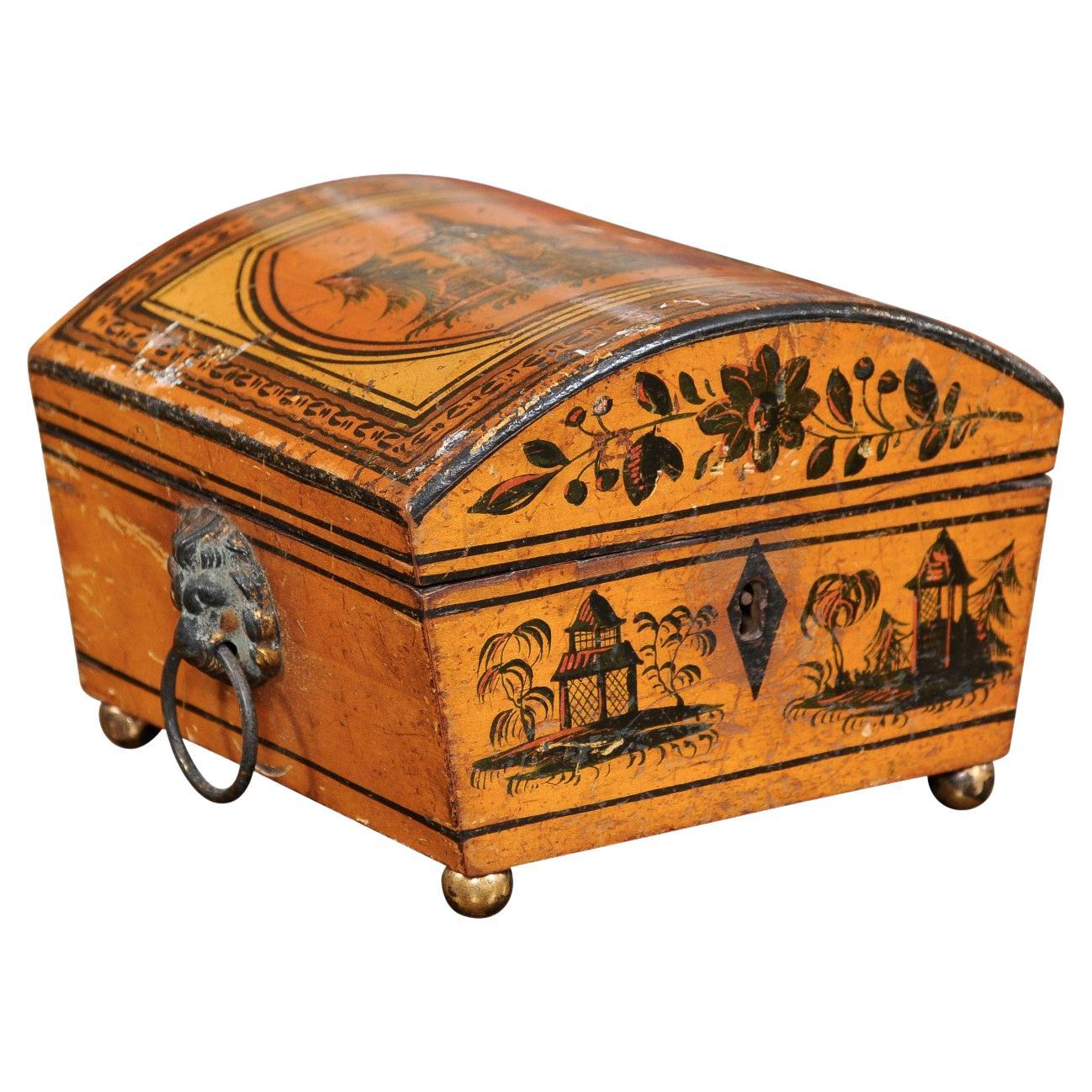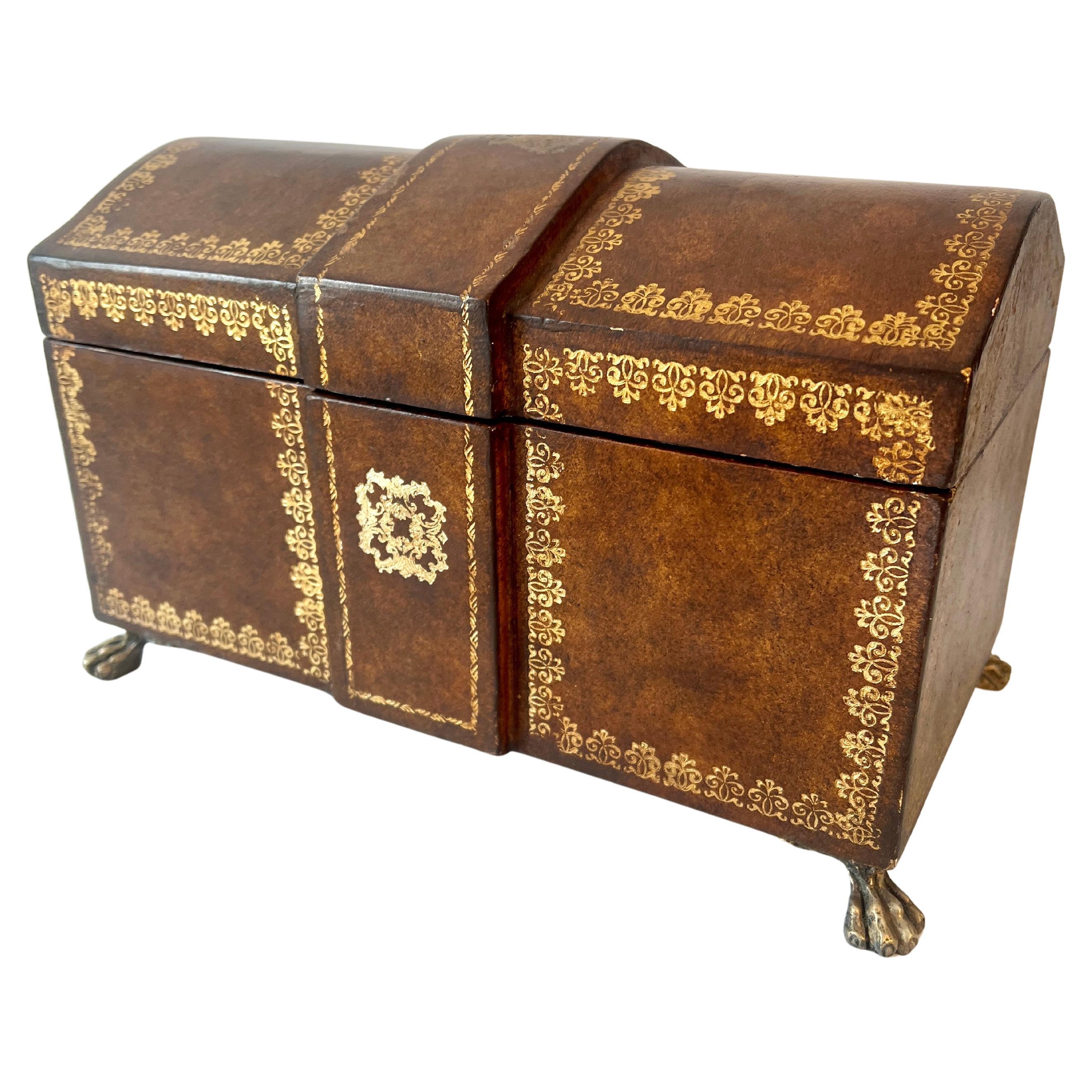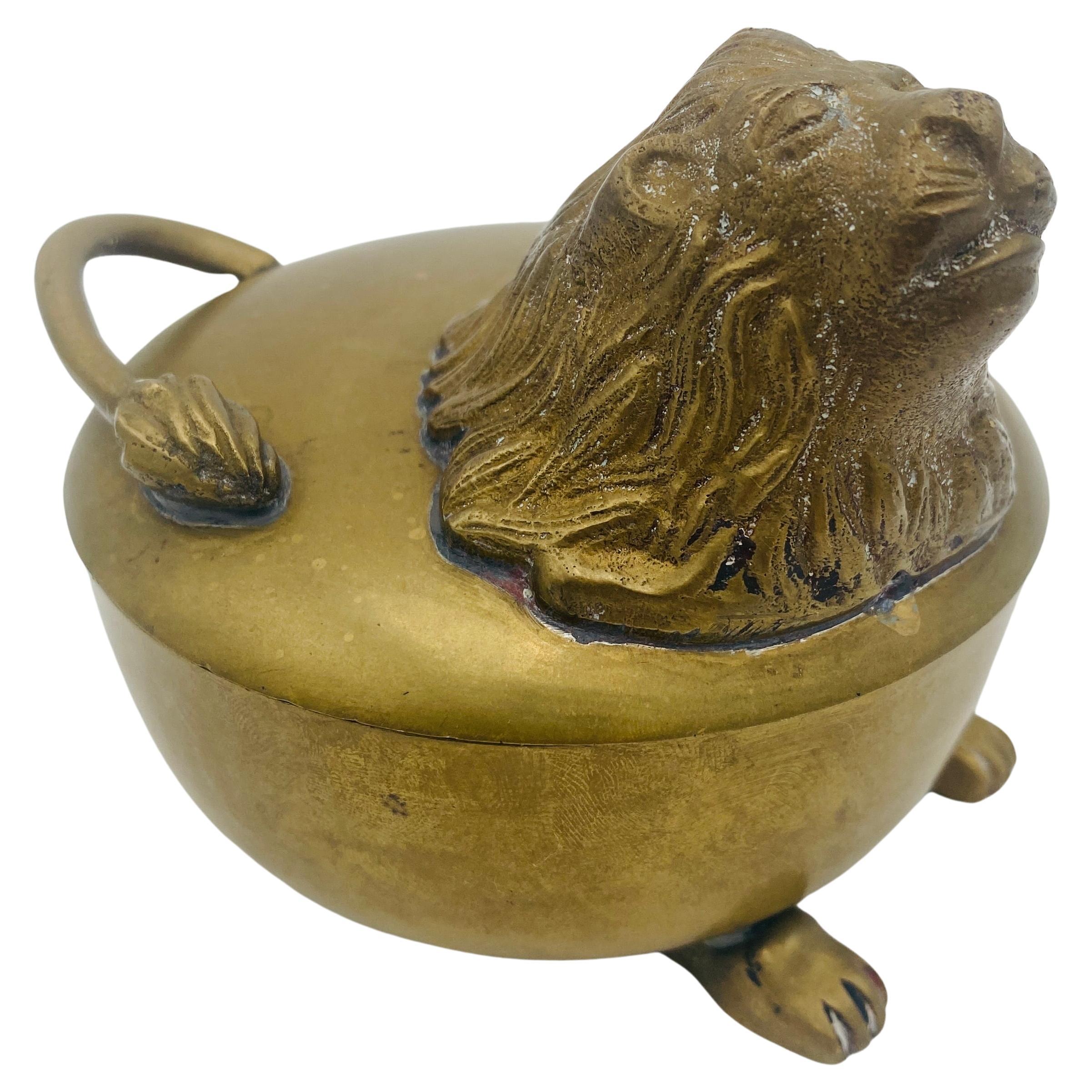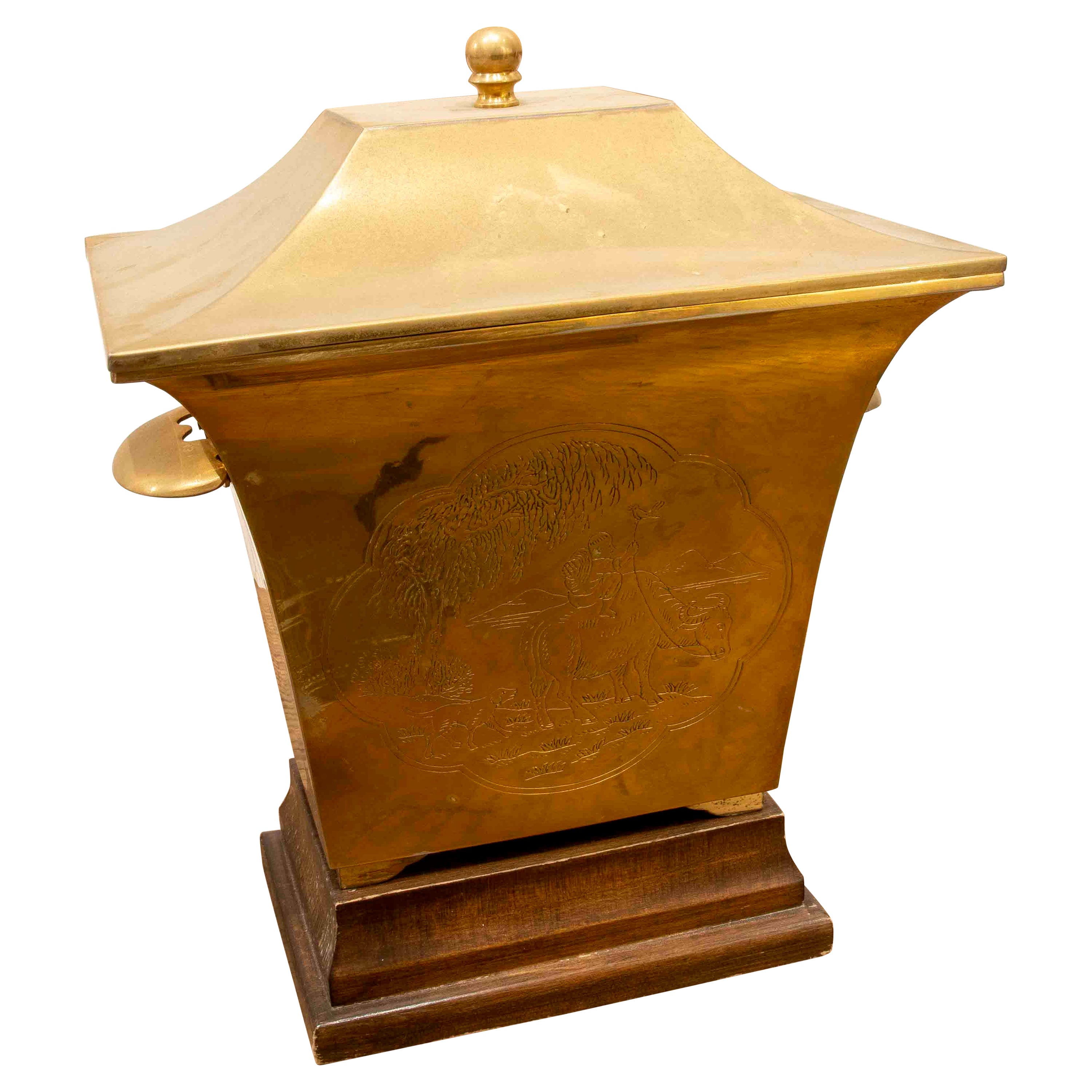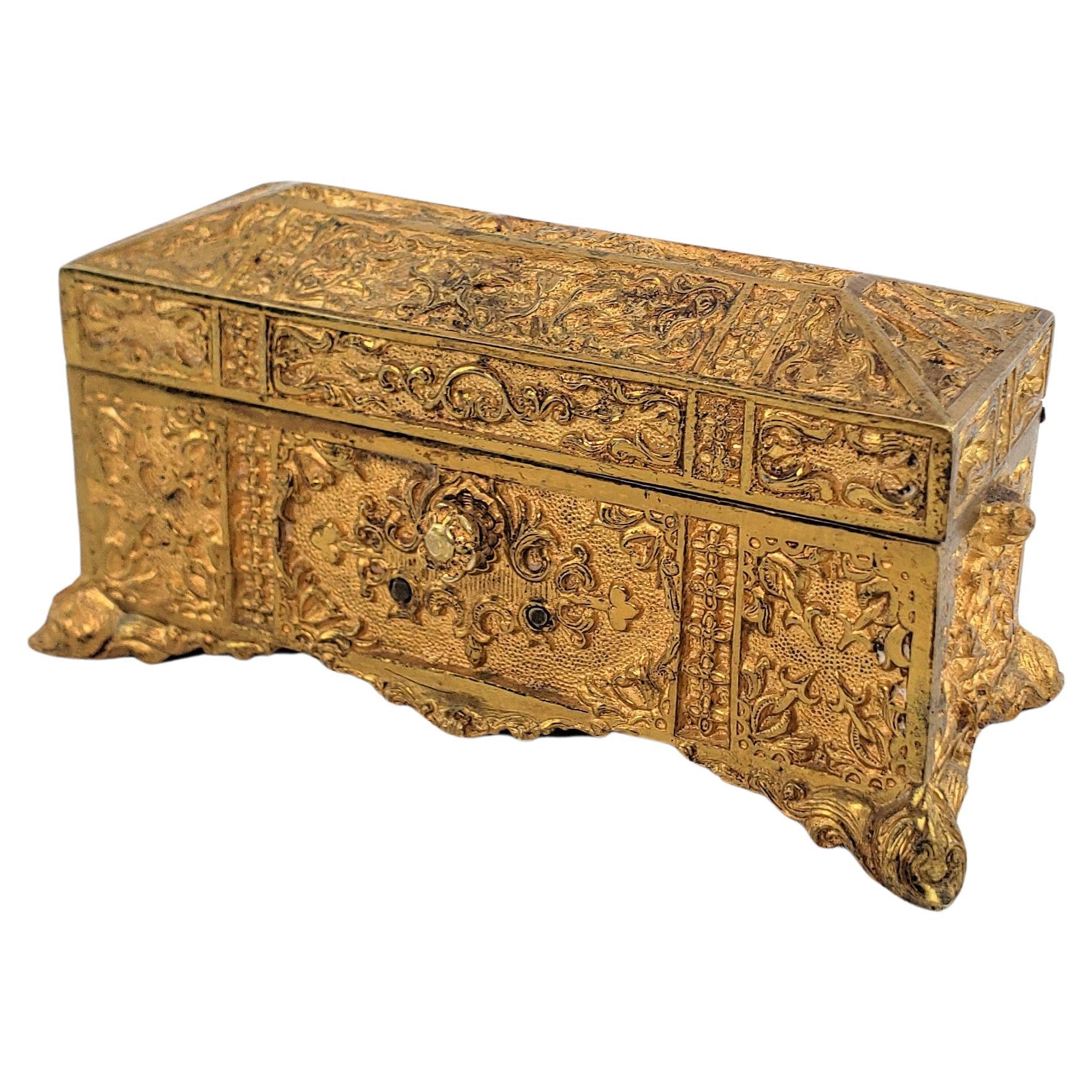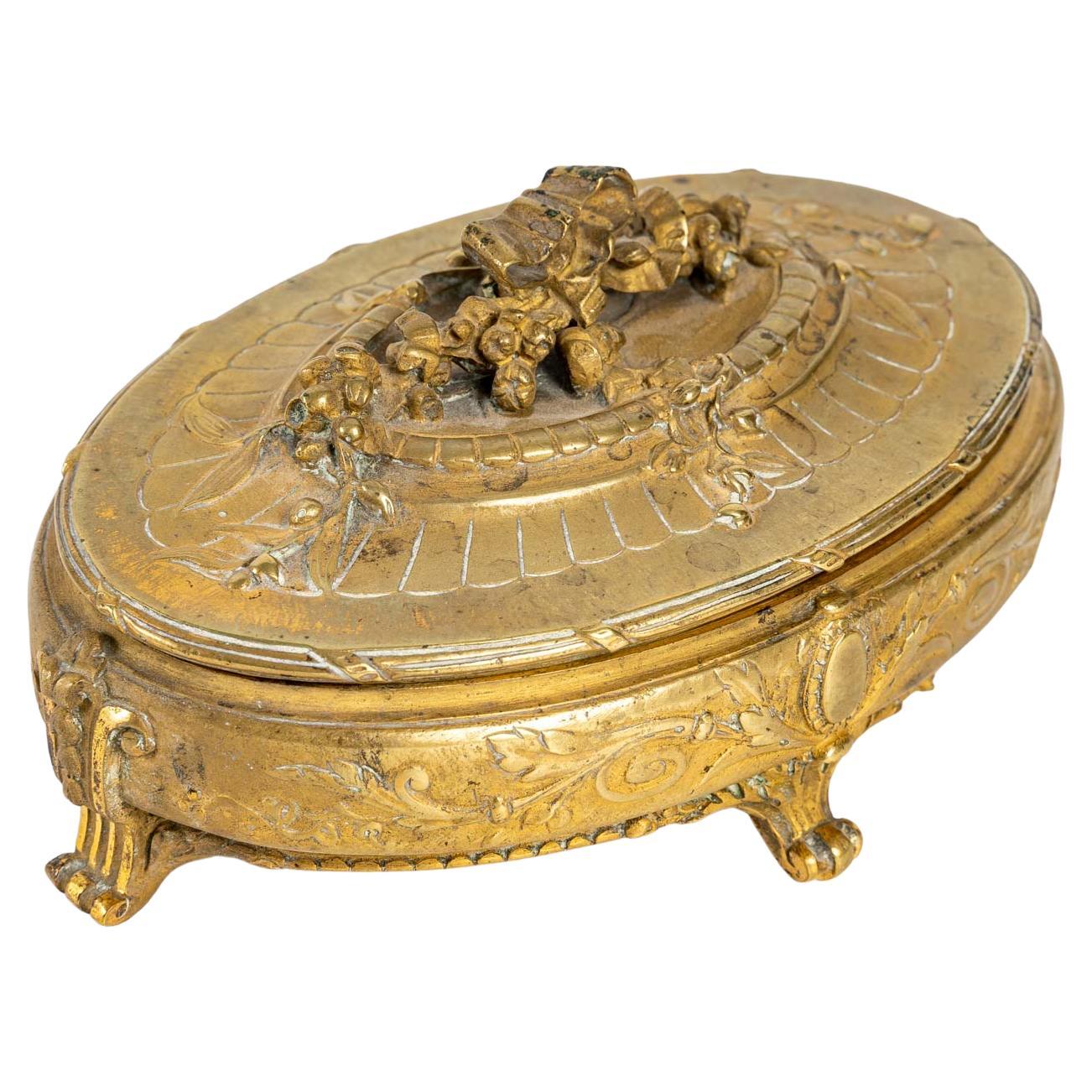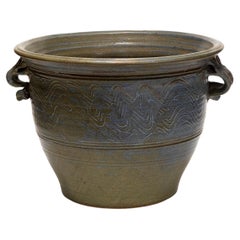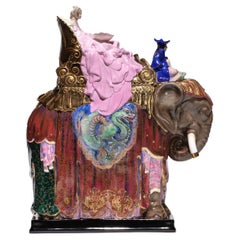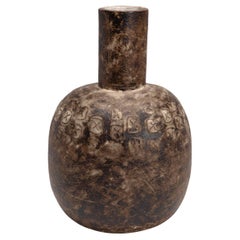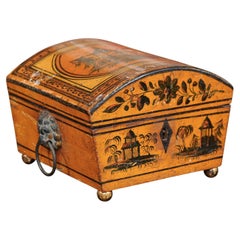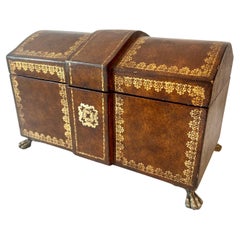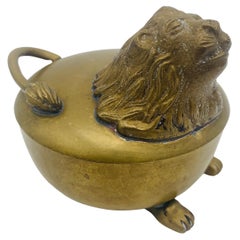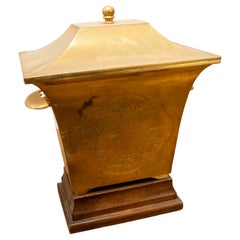Items Similar to "Victory 1805" Brass Box, Warm Color, Embossed Design, Lion's Head Handle
Want more images or videos?
Request additional images or videos from the seller
1 of 10
"Victory 1805" Brass Box, Warm Color, Embossed Design, Lion's Head Handle
$1,600
£1,187.91
€1,384.25
CA$2,221.32
A$2,484.68
CHF 1,293.04
MX$30,587.29
NOK 16,450.19
SEK 15,433.52
DKK 10,327.87
Shipping
Retrieving quote...The 1stDibs Promise:
Authenticity Guarantee,
Money-Back Guarantee,
24-Hour Cancellation
About the Item
SALE ONE WEEK ONLY
"Victory 1805" brass box has exceptional details, the lion's head fixtures with brass rings, lions feet on which the box stands and the embossed etching of a sailing ship on the lid. The brass rings and the lid work perfectly and smoothly. The name "Victoria 1805" is pressed into the front side. Brass boxes were very popular during the 1800s and used for all number of purposes to hold trinkets, jewelry, pens, cigars. The inside is unfinished and may at one time have had a padded satin or velvet lining which has disintegrated. The box shows loving care and is a soft warm golden color unblemished. The sailing ship on the lid is quite an extraordinary and unique rendering of a nine sail rig at full sail set in a scene with moving waves and flying birds. The majority of brass boxes are decorated with flowers or repetitive designs nothing as special of this lovely landscape. It may have belonged to a man and even perhaps to a Captain of such a ship on the open seas. This box was formerly auctioned off by Leslie Hindman Auction House.
- Dimensions:Height: 3.75 in (9.53 cm)Width: 9 in (22.86 cm)Depth: 7.5 in (19.05 cm)
- Style:American Colonial (Of the Period)
- Materials and Techniques:
- Place of Origin:
- Period:
- Date of Manufacture:1800s
- Condition:
- Seller Location:Bloomfield Hills, MI
- Reference Number:1stDibs: LU7781233533022
About the Seller
5.0
Vetted Professional Seller
Every seller passes strict standards for authenticity and reliability
1stDibs seller since 2022
19 sales on 1stDibs
Typical response time: 1 hour
- ShippingRetrieving quote...Shipping from: Detroit, MI
- Return Policy
Authenticity Guarantee
In the unlikely event there’s an issue with an item’s authenticity, contact us within 1 year for a full refund. DetailsMoney-Back Guarantee
If your item is not as described, is damaged in transit, or does not arrive, contact us within 7 days for a full refund. Details24-Hour Cancellation
You have a 24-hour grace period in which to reconsider your purchase, with no questions asked.Vetted Professional Sellers
Our world-class sellers must adhere to strict standards for service and quality, maintaining the integrity of our listings.Price-Match Guarantee
If you find that a seller listed the same item for a lower price elsewhere, we’ll match it.Trusted Global Delivery
Our best-in-class carrier network provides specialized shipping options worldwide, including custom delivery.More From This Seller
View AllJohn Glick Ceramic Garden Planterette Signed
By John Glick
Located in Bloomfield Hills, MI
The Ceramic Garden Planterette is an example of the kind of work by which John Glick became so famous. He was seduced by the effects of the reduction kiln, which decreased the levels of oxygen during firing, inducing the flame to pull oxygen out of the clay and glazes changing the colors of the glazes depending on their iron and copper content. In this way he achieved the rich gradients of ochre and umber and variations in stippling and opacity. The piece is signed by Glick and stamped with the name of his studio: Plum Street Pottery on the verso.
John was an American Abstract Expressionist ceramicist born in Detroit, MI. Though open to artistic experimentation, Glick was most influenced by the styles and aesthetics of Asian pottery—an inspiration that shows in his use of decorative patterns and glaze choices. He has said that he is attracted to simplicity, as well as complexity: my work continually reflects my re-examination that these two poles can coexist… or not, in a given series. Glick also took influences from master potters of Japan, notably Shoji Hamada and Kanjrio Kawai, blending their gestural embellishments of simple forms with attitudes of Abstract Expressionism. He was particularly drown to the work of Helen Frankenthaler whose soak-stain style resonated with Glick’s multi-layered glaze surfaces, which juxtaposed veils of atmospheric color with gestural marks and pattern. He spent countless hours developing and making his own tools in order to achieve previously unseen results in his work with clay and glaze.
Glick’s “Plum Tree Pottery” (now a designated historic landmark in Farmington Hills, Michigan) studio opened around 1965 and closed in the summer of 2016. It was a private studio space for John and a number of his students and assistants. He believed his shapes evolved guided by forces apparently outside his control. This was instinctual, intellectual and due to his openness to change, fusing into what he thought was the most positive force behind a potter’s approach: evolution and growth. Some have called it inspiration.
John was not only a major figure in the Detroit creative community, but in the ceramics world at large. According to Shelley Selim in her book on John, “John Glick: A Legacy in Clay” John remains: “one of the most recognizable names in the field of studio pottery – known for lecturing, publishing, and offering workshops widely – and his work has been featured in well over a hundred local, national and international exhibitions since he was a college student in the late 1950s.” Along with this John has mentored over thirty studio apprentices over five and a half decades, received numerous grants and awards for his work, and has been prolific, with an estimated 300,000 ceramic wares throughout the world.
He received his Masters from Cranbrook Academy of Art in Bloomfield Hills, Michigan, working with Maija Grotell, a legendary and influential teacher. Grotell was noted for her deep interest in the human connection to nature’s rhythms and patters. These ideas often grounded her dialog with her students including Glick, affecting, a profund and lasting influence on his future work. This famous Art Academy was designed by architect and faculty member, Eliel Saarinen who collaborated with Charles and Ray Eames on chair and furniture design. Numerous creative artists who are alumni of Cranbrook include: Harry Bertoia, Florence Knoll, Jack Lenor Larsen, Donald Lipski, Duane Hanson, Nick Cave, Hani Rashid, George Nelson, Urban Jupena (Nationally recognized fiber artist), Artis Lane (the first African-American artist to have her sculpture, "Sojourner Truth," commissioned for the Emancipation Hall in the Capital Visitor Center in Washington DC), Cory Puhlman (televised Pastry Chef extraordinaire), Thom O’Connor (Lithographs), Paul Evans (Brutalist-inspired sculpted metal furnishings), Eugene Caples (small bronze images/abstract), Morris Brose (Bronze Sculptures), Herb Babcock (blown glass), Larry Butcher (mixed media) and Lauren Anais Hussey...
Category
1990s American American Classical Planters, Cachepots and Jardinières
Materials
Ceramic
Hutschenreuther Hans Achtziger Porcelain Figurine "TIGER" Marked #5 on Base
By Hutschenreuther
Located in Bloomfield Hills, MI
Rich orangish gold and black stripe the Hutschenreuther Tiger that appears to be on the prowl. To see this tiger is to be reminded of the great poem by William Blake: "Tyger Tyger, b...
Category
Vintage 1970s German Porcelain
Materials
Porcelain
"Princess Badoura" "Royal Doulton Prestige Collection" Porcelain HN2081
By Royal Doulton
Located in Bloomfield Hills, MI
Princess Badoura was the most prestigious and expensive figure ever made by Royal Doulton. It was made to order for wealthy clients for nearly 50 years and a special color version was devised for Harrods of London. In addition, it has 22 carat gold decorations. Three different models are on display in the Fantastique exhibit at Weiner Museum Of Decorative Arts and Princess Badoura is one of the stars of the Celebration of Ceramic Art weekend. The glazes are as rich as luxurious silk and the gold decorations are perfection. It is one of the most sought after in the Princess Badoura productions. This piece was hand-painted.
In the Tales of the Arabian Nights, Badoura is a princess of China and the most beautiful woman ever seen upon the earth. She magically falls in love in her sleep with Prince Camar of Persia thanks to the supernatural antics of two genies, who boast of their rival beauty. In defiance of their families, the young couple steadfastly refuse to marry anyone else until they are reunited after a quest for each other across Arabia. Their dreams come true and the princess travels to her wedding in great splendor on the back of an elephant. This enchanting story was illustrated by Edmund Dulac in 1907 and by George Barbier in 1922.
This spectacular piece was modeled by Harry Stanton as a centerpiece for the Wembley Exhibition in 1924 and joined the Royal Doulton's Prestige Collection in 1952. Our piece was produced in 1983 and signed by the grandson of the founder, Michael Doulton, in 1985. Each figurine required over 160 hours of intricate painting and five kiln firings before the gilders added the final embellishment of 22 carat gold. This is a limited edition of 500.
Royal Doulton is an English ceramic and home accessories manufacturer that was founded in 1815 by John Doulton at Lambeth, London in association with John Watts...
Category
Late 20th Century English Porcelain
Materials
Gold
Claude Conover Ceramic Stoneware Vessel Signed "Comitan" Inscribed Decorations
By Claude Conover
Located in Bloomfield Hills, MI
SALE ONE WEEK ONLY
"Comitan" is a stoneware vessel, 1980s, with a handsome elongated neck and full-body. The surface has a rich warm patina with cryptic scratches, stripes and hatchings marking the body. This gorgeous piece is a perfect example of Conover's best work.
Claude Conover was a ceramic sculpture artist described as falling within the styles of American, Modern and Contemporary Design. In 1983 he won The Cleveland Arts Prize competition in the visual arts for his bold and unique ceramic pieces that reflect strength of form and endurance unusual in the field. Using his own clay stoneware and mostly monochromatic colors, Conover decorated the surfaces with cryptic scratches, stripes and hatchings. Although decorative in intent, the indecipherable incised lines on his ceramics suggest some prehistoric unreadable script. The resultant works evoke a timeless monumentality reminiscent of ancient vessels whose utilitarian purpose is now lost to us. Within this limited repertoire, he produced beautiful, eternal works of art. Although Conover’s large impressive pots are his best work, he also made other forms, such as bowls, lamps, and ceramic animal sculpture.
Conover was born in Pittsburgh and educated at the Cleveland Institute of Art, where a number of prominent artists also attended: Brian Michael Bendis, Marc...
Category
Vintage 1980s American Vases
Materials
Ceramic, Stoneware
Royal Copenhagen Porcelain Figurine "MUSK OX" Erik Nielsen 1938 #530 Very Rare
By Royal Copenhagen
Located in Bloomfield Hills, MI
The beautiful and majestic Musk Ox is captured in all its strength and quiet beauty in #530 by Erik Nielsen in 1903 for Royal Copenhagen. The markings on ...
Category
20th Century Danish Animal Sculptures
Materials
Porcelain
Royal Doulton Red Flambe Porcelain Figurine "TIGER"
By Royal Doulton
Located in Bloomfield Hills, MI
Over 500 years ago Chinese potters first experimented with copper oxide glazes to create a fiery red finish that became known as Flambe. When these Sung Dynasty (AD 960 to1279) porce...
Category
Mid-20th Century English Animal Sculptures
Materials
Porcelain
You May Also Like
19th Century English Penwork Box with Lion’s Head Handles & Brass Ball Feet
Located in Atlanta, GA
19th Century English Penwork Box with Lion’s Head Handles & Brass Ball Feet
Category
Antique 19th Century English Decorative Boxes
Materials
Wood
Hand Crafted Leather and Gold Tooled Hinged Box with Brass Lion Paw Feet
Located in Los Angeles, CA
A lovely leather box with Gold tooled leather. In the shape of a treasure box, with a raised center portion, the box is unique in shape and style.
A compliment to any desk to hold...
Category
20th Century English Decorative Boxes
Materials
Gold, Brass
Solid Brass Lion Stash Box with Feet 20th Century
Located in San Juan Capistrano, CA
This is an excellent solid brass stash box with a carved lion's head and four feet. This piece is both functional and decorative.
Category
20th Century Unknown Mid-Century Modern Decorative Boxes
Materials
Brass
Brass Box with Lid and Handles, Wooden Base and Embossed Decoration on Sides
Located in Marbella, ES
Brass Box with Lid and Handles, Wooden Base and Embossed Decoration on Sides
Category
Late 20th Century Asian Decorative Boxes
Materials
Brass
Antique Gilt Bronze Decorative Jewelry Box or Casket with Floral Decoration
Located in Hamilton, Ontario
This antique gilt bronze decorative or jewelry box is unsigned, but presumed to have originated from France and dates to approximately 1900 and done in a Renaissance Revival style. T...
Category
Early 20th Century French Renaissance Revival Jewelry Boxes
Materials
Bronze
Chased Bronze Jewellery Box, 19th Century
Located in Saint-Ouen, FR
Chased bronze jewellery box, 19th century
Chased bronze jewellery box, red silk inside, Napoleon III period, 19th century
Measures: H: 7 cm, W: 16 c...
Category
Antique 1870s European Napoleon III Jewelry Boxes
Materials
Bronze
More Ways To Browse
Antique Ring Boxes Jewellery Boxes
Bird Jewelry Box
Antique Sailing Ship
Lions Head Handles
Antique Lion Ring
Mans Jewlery Box
Unfinished Antique Furniture
Early American Bedroom Set
Lion Head Bedroom Furniture
Sea Lion
Brass Etching
Sea Captains Furniture
Antique Rigs
Cigar Stand
Sea Captains 19th
Brass Flying Birds
Antique Floor Mirrors
Art Deco Art Nouveau Lamp
